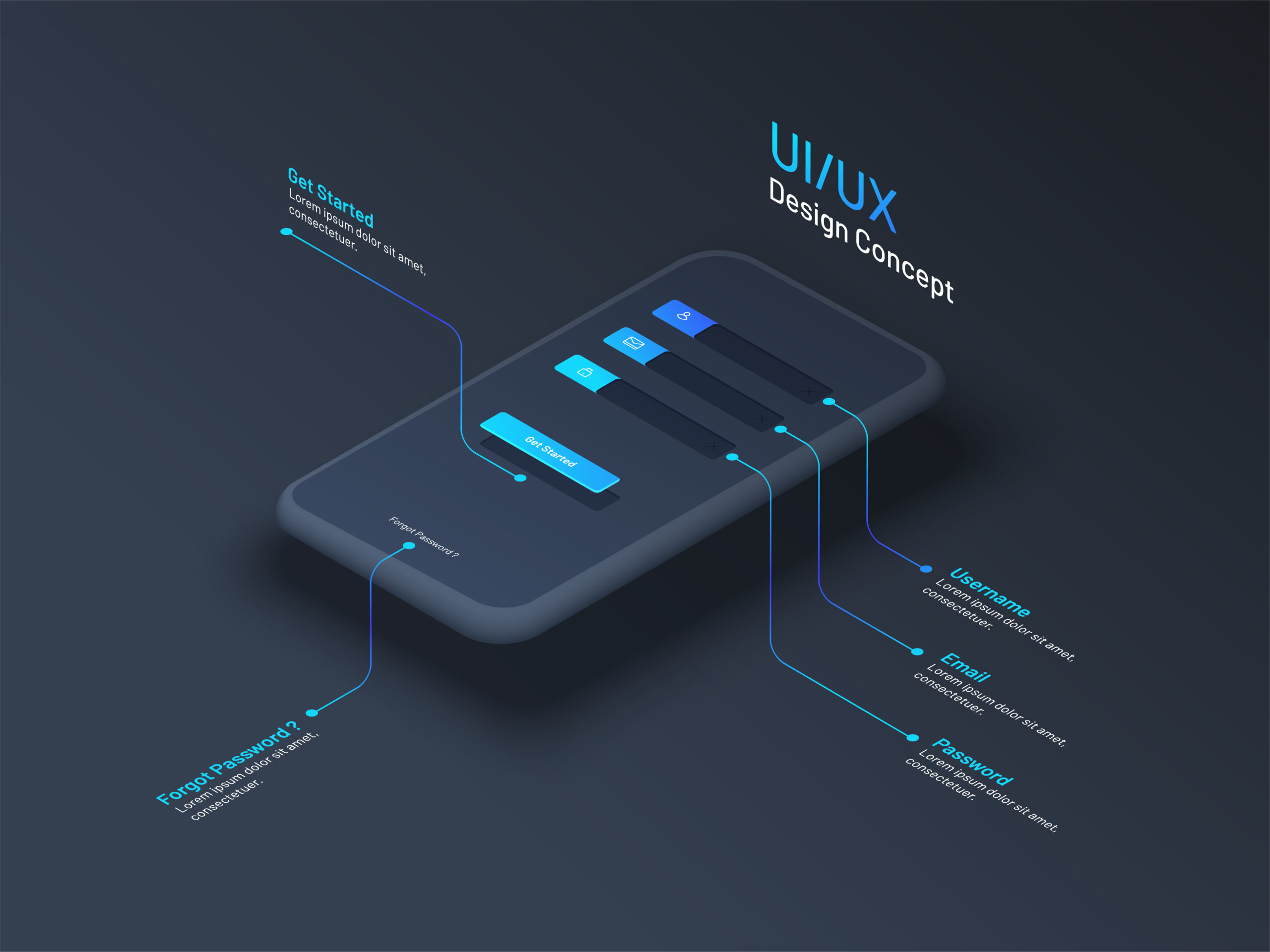How To Use AI In UX Design Workflows Without Sacrificing Creativity
Estimated Reading Time:
10
Minutes

We’ve explored AI in UX design from technological capabilities to helpful tools, but we haven’t touched on workflow impact and best practices yet.
If you’re a frequent reader of our blog, you already know we’re pro-AI because of its potential to streamline our work. However, there’s still growing concern among creatives regarding the quality and ethicality of its output.
Listen, we’re just a small, award-winning UX firm. We know we’re not going to single-handedly shift the global perception of AI in a few simple blogs. But we can share tips and tricks to help designers embrace these new technologies without disregarding creativity or innovation!
How To Use AI In UX Design Workflows
- Divergent Thinking
- Expanding Services
- Idea Evaluation
- Challenging Biases
- Team & Stakeholder Collaboration
- Data Analyzation
- Quality Control
How Is AI Evolving In The UX World?
With all its speed and convenience, it’s fair to say that AI is more efficient than the average human. It can process vast amounts of data within seconds from relatively simple commands, helping us automate tasks, identify patterns, expand on ideas, and even predict behaviors.
Still, AI is far from flawless. Need some evidence? Well…take a look at this uncanny horror courtesy of Adobe Firefly.

This is why AI won’t replace UX designers anytime soon — it’s not a cut-and-paste solution. Many designers use it as a jumping-off point, letting the algorithms connect the dots so we can get those strategic and creative wheels turning.
That being said, it’s still an uneasy feeling when products like Relume or Uizard come along and automate a process that normally takes you hours. It’s on us to master these systems, utilizing the algorithms to boost our quality and productivity (instead of relying on the machines and turning in sub-par products).
It’s a fine line to balance, especially when caught between multiple projects and tight deadlines. However, a strategic approach to AI in UX design guided by ethical best practices will help you find seamless ways to integrate it into your workflow and enhance your creative output.
7 Tips For Working AI Into Your UX Design Process
With every new AI-driven platform, there’s always a bit of a learning curve before you get comfortable with the system. Some will also prove more useful to your process than others. The most important thing to do is play around with a few different products and features until you find the ones that benefit you most.
By following these strategic AI methods and keeping an open mind around new technologies, you can quickly adopt these game-changing solutions to become a more productive and indispensable UX designer.
Embrace Divergent Thinking
Brands typically start with lots of ideas and assets. It's difficult to narrow things down into one viable idea in a few brainstorming sessions. This is where AI visualization and iteration come in handy, providing multiple proofs of concepts, giving your clients more options, and inspiring confidence for the project going forward.
Divergent thinking (in this context) is how AI pulls together remote (and sometimes discordant) ideas into one entity. Art generators with text-to-image algorithms have the power to detect resemblances between objects or images, combining them into one concept or elaborating further.
Think about when AI art tools first gained popularity. Maybe you had a friend on social media creating or sharing the most outlandish mash-ups they could think of (stuff like Shrek dressed up as Thor or Garfield hacking the CIA). That’s divergent thinking at work.
But it goes beyond generating low-tier memes. These divergent capabilities are instrumental when creating logos, color palettes, stylescapes, and page templates. By spotting similarities between objects utilizing AI, you can create a foundation for your design efforts and flesh out some details before you start working.
Looking at this example from the Harvard Business Review, there are no physical similarities between an elephant and a butterfly. But by recognizing the patterns between the wings and the ears, Midjourney grouped them to create a stunning image (which we think would make an awesome logo, by the way)!

Consider Expanding Your Services
We discussed using AI in UX design to fill in skill gaps in the blog about our favorite AI tools. But they can also be leveraged to your business’ advantage (or your own if you’re a freelancer).
Between product design, animations, written content, and development, UX projects are hectic by nature. We don’t recommend going over a specialist’s head and trying to do something out of your skill set. However, you can significantly streamline the process by using AI to create an example of your vision, leading to a clear and accurate execution.
AI’s collaborative benefits are readily apparent, but they’re also an excellent professional development tool. With all the new platforms and plug-ins being introduced, you can train yourself in a whole new UX discipline.
Let’s say you’re a UX designer who’s not a skilled copywriter. You’ve spent plenty of time interfacing with your client’s brand and familiarized yourself with their voice and tone. You can enter a prompt into Jasper.ai or ChatGPT to cover all the crucial points you’re trying to convey, then tweak the AI’s output to reflect their brand identity from there.

As you’re familiarizing yourself with the AI’s suggestion and expanding your writing style, you’re nurturing a whole new skill set that helps you deliver a cohesive product that’s true to your vision.
Just don’t forget that practice makes perfect. Always do a few trials before charging your clients for additional services.
Evaluate Your Ideas
Whether you’re narrowing down an artistic direction or measuring KPIs post-launch, there are a plethora of AI tools that gather relevant data insights to streamline decision-making.
Through automated user testing, A/B testing, and heatmapping, we can reduce the time it takes to set up user trials and process data — giving us a clear-cut path to our goals and eliminating personal biases.
Of course, these tools are more helpful when evaluating an existing digital product or testing a new flow. There’s no way it could give you insights into the viability of your proposed solution, right?
WRONG! There are a ton of systems that can gauge the feasibility of ideas and help you weigh the pros and cons. In fact, the authors of the Harvard Business Review article we mentioned earlier did a short experiment with ChatGPT to explore different solutions for eliminating food waste.
Beyond ChatGPT, tools like Checkmyidea-ia and Test & Start can perform foundational market research, provide technical MVP proposals, and generate recommendations from technology stacks to startup names. These tools are a lifesaver for research teams with limited timelines and resources!

Challenge Your Biases
While AI’s output can be skewed depending on user entries, it’s still valuable in evaluating high-quality data for objective insights.
Designers can utilize AI systems that incorporate ethical guidelines and principles, helping them avoid inadvertently reinforcing biases within their designs. AI can flag potential bias issues and suggest alternatives to maintain fairness and inclusivity.
If used correctly, the algorithms can identify bias in data, content, or design elements — highlighting areas of concern and prompting designers to address biases proactively.
Think the benefits of AI in bias evaluation stop there? Nope, there’s also a significant advantage in the large pool of diverse data the system gathers.
Algorithms can access vast datasets from various sources, including user feedback, demographics, and behavior. This diverse data provides a more comprehensive understanding of user needs, preferences, and behaviors.
HOWEVER (and it’s a big however), it's essential to research and utilize AI systems that are developed and trained with ethical considerations to prevent bias propagation. By actively seeking out and leveraging tools that promote fairness, diversity, and inclusivity, we can work towards creating more equitable user experiences.

Collaborate With Teams & Stakeholders
If you’re a remote team of international UX wizards (like us), you know how difficult communication can be. Even though collaboration tools like Figma and Slack help us keep in touch throughout the day, AI tools can help us close gaps and enhance productivity.
Beyond automated testing and data insights, AI in UX design enables team members and stakeholders to work together on projects in real time. This reduces communication barriers and ensures visibility throughout the design process.
It also helps you make quick fixes to a design (CTA color or text alignment adjustments) when you’re presenting your work to a client, expediting approvals and minimizing back-and-forth emails for edits.
Plus, if interpersonal communication isn’t your strong suit, there are plenty of presentation and note-taking tools that can read your tone and detect filler words (like Poised) or produce transcripts and sum up key takeaways (like Fireflies.ai). These systems can help you passively improve your communication skills on the fly and gain the trust of your clients and colleagues.

Analyze Data Accurately
UX is primarily a creative field, but the numbers matter if we want to create impactful user experiences. We rely on validated and accurate data to hypothesize, innovate, and execute our solutions — and AI can assist us in making connections with the numbers!
While we just discussed the potential biases of AI in UX design, it still processes numbers faster and with fewer errors. By identifying patterns, trends, and anomalies within the data, AI helps designers make more informed decisions based on objective insights.
By automating data collection, the algorithms can spot abstract or incomplete feedback, prioritizing high-quality, relevant information for analysis. This automation saves designers time and minimizes the inaccuracies of manual data handling.
Additionally, AI can perform complex statistical analyses and predictive modeling tasks beyond the average designer’s capabilities. With these advanced analytics, we can uncover hidden insights, anticipate behaviors, and make adjustments throughout the design process.
So, even if you're blessed with both creativity and an AP understanding of math, the speed and precision of AI algorithms can help any designer double-check their work and expand their ideas with validated data.

Enhance Quality Control
User testing is our main quality control strategy, but once our prototypes are assembled and coded, we still need to guarantee everything’s bug-free and behaves as intended before launch. Enter the QA stage — an absolute must before users interact with the MVP.
Luckily, AI algorithms are useful throughout the entire design process (both pre- and post-launch). They can significantly enhance quality control efforts by processing functions and providing data-driven insights to meet our high standards.
There are automated tools for AI user testing that can simulate design interactions and provide objective feedback. However, we'll accept biased feedback from our users to understand why something doesn’t work for them. So we don’t recommend using them to replace testing with real users.
Instead, AI-driven testing tools for accessibility, cross-device performance, security, and bug detection help us evaluate our work and pay close attention to the details.
Along with content and SEO optimization platforms, there are also tools designed to spot inconsistencies in visual designs — giving us a chance to fine-tune branding elements and ensure the consistency our users want. Whether you’re a designer, developer, or a little bit of both, the benefits of AI in UX design processes are unignorable.

Best Practices For AI In UX Design
To some, AI is a magical solution for all their design shortcomings. To others, it’s the boogeyman coming to take their job. Whatever your viewpoint is, it’s important to approach your AI uses with some ethical best practices (whether you’re using it enthusiastically or begrudgingly).
- Understand the Problem Before Implementing AI: Thoroughly comprehend the problems you’re trying to solve before consulting the algorithm. AI should complement your design process, not be a solution in search of a problem.
- The User is the Focal Point: Keep users at the center of your design process. Continuously gather and incorporate user feedback to stay focused on user needs.
- Lead with Ethics: Follow the news and updates associated with AI to remain aware of ethical concerns as they arise. Always use your best judgment and weigh your options before utilizing a system.
- Test, Test, Test!: Regularly conduct usability testing, even when AI is involved. Test how users interact with AI-driven features and assess whether they enhance or hinder the user experience. Use the feedback to make improvements.
- Prioritize Safety & Security: Safeguard user data and adhere to relevant regulations, such as GDPR or CCPA, when implementing AI-driven data.
- Evolve with the Technology: Stay updated with AI advancements and emerging technologies in the UX field. Keeping your knowledge current ensures you can leverage the latest tools and techniques.
- Be Prepared to Pivot: Don’t despair if your AI system encounters issues. Instead, explore different platforms or provide feedback to improve the algorithm.
Put Your Creativity Front-and-Center!
We know AI is the future of design, and the future can be scary! But it’s neither a cure-all solution to your work woes nor the decline of human creativity as we know it. Instead, we see it as the helping hand all designers need every now and then.
Whether working solo or collaborating with a trusted team, AI can be your secret weapon to enhance quality control, analyze data accurately, and take your designs to new heights. Or it can help you through a dreaded brain block or tight timeline.
With the right balance of technology and human-powered ingenuity, you’ll become a more productive and well-rounded asset to your design team.
Remember, AI isn't here to replace your creativity; it's here to supercharge it! So embrace these AI-powered strategies, experiment with new tools, and let your UX skills shine.
If you’re looking for a UX job where you can explore this new AI frontier, we may have an opening for you. Check out our positions and apply today!
Share:
Let’s Work Together!
It’s a jungle out there — let the Create Ape experts help you traverse the wilds as we take your project to new heights.












.jpg)































.png)
















.jpeg)










.png)






















